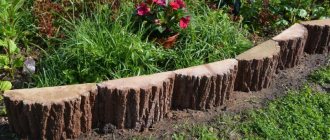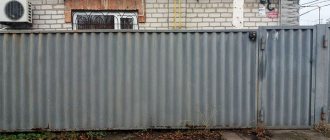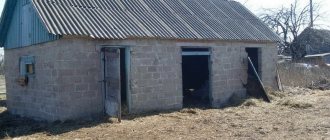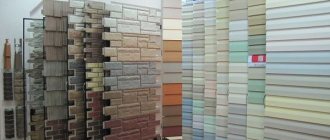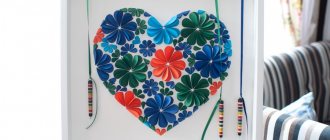Landscape Design Rules
The main area of the dacha is occupied by healthy fruit and berry plantings, vegetables and herbs. Naturally, there is very little space left for a flower garden.
As a rule, these are spaces along fences and near a country house. To fill this void, you need to know the principles of flower bed design.
Before deciding what to plant, you need to answer the following questions:
how much area is planned to be devoted to a flower garden. If the flower bed near the fence is long and large, then the choice of plants is practically unlimited. If there is very little space in the dacha, then the flowers should be miniature and not “aggressive”.
When planting, it is important to plant plants with the same requirements for watering, soil, and light. To do this, you need to find out which side the fence is on (sunny or shady), what crops the dacha owner plans to plant (whether they require care or not).
Flower garden along the fence Source pinterest.com
Near what kind of fence will there be a flower garden: solid or sparse (made of wooden slats, chain-link mesh, metal profile). What is the height of the fence, how hot does it get, whether it is necessary to hide the fence with plantings or leave it open.
When planting plants on the south side of the site, choose drought-resistant crops that need a lot of light. The soil in this part of the dacha will need to be constantly watered, so it is not recommended to plant delicate plants here that require abundant watering: crocuses, tulips. For a flower bed along the southern part of the fence, planting thyme, iris, and mallow is perfect.
On the northern side of the site, plants that can withstand strong winds and are cold-resistant are planted. For a flower bed near a fence, hosta plantings, stone compositions with coniferous shrubs, horizontal juniper, and ferns are well suited. In addition to low-growing plants, tall thujas can be planted on the side of the fence.
Most often, a flower bed is made with smooth borders and curves, as in this photo Source samozvetik.ru
Rigid rectangular flower beds can be arranged in the form of small compositions of flowers of different colors, but of the same type. For example, marigolds, petunias.
Flower arrangement Source pinterest.com.mx
Lupines have absorbed all the colors of the rainbow
I grew them. We liked them for their unpretentiousness and appearance. They grow into lush bushes. The foliage is beautiful, openwork.
Lupins by the fence
There are a lot of advantages. The seeds are large, sowed directly into the ground. Lupine, a member of the legume family, also enriches the earth with natural nitrogen. There is no color of the rainbow that is not found among lupins: red, yellow, blue, blue, orange, and also pink, white, lilac, violet.
There are also disadvantages:
- They grow quickly both by root and by self-sowing. Old bushes bloom worse; they need to be divided and replanted.
- There were cases that in the spring lupine did not grow back from the old root, or frail branches grew, and there were no flowers.
- They bloom for a short time - 3 weeks in May or June.
- After flowering they look ugly; instead of buds, beans with seeds appear and turn yellow. You need to cut off the flower stalks.
But I already miss lupins and want to plant them again?
The flower is not picky about soil, but grows better on moderately moist soil, without stagnant water. Loves sunny places.
Planting along a mesh fence
To decorate a chain-link fence, many people use ordinary climbing plants: hops, virgin grapes, Jerusalem artichoke.
Flower garden Source news.rambler.ru
Some owners plant beans or peas.
In addition to them, a flower garden is planted, consisting of shade-tolerant plants and undemanding plants: lupine, rudbeckia (golden ball).
A flowerbed next to a mesh fence can consist of perennials Source sewerge.ru
Planting along a wooden picket fence
A rare picket fence can be decorated on the wall side with tall flowers, for example, hydrangea, mallow or sunflower, and of course vines. These are girlish grapes, clematis, actinidia. And along the perimeter there are medium-sized or low-growing shade-loving crops.
In addition to flowers, it is popular among gardeners to plant small shrubs along wooden fences, such as honeysuckle, raspberries, currants, lilacs and others.
As for flowers, marigolds, petunia, and lobelia are used as low-growing flowers along the fence. First, a raised platform is used to organize the flower bed. Landscape design of a flower garden does not exclude hand-made. This can be any available materials: tires, tree logs, beautifully dug along the perimeter of the curb.
Small carts or even vintage bicycles that are used as flower beds Source urlaubitaliano.de
Corrugated sheeting, brick or natural stone
Even an openwork fence built of brick, and even more so a crudely deliberate stone structure, suggests the use of only plants under them that are accustomed to the shade. On a narrow strip under such a fence, there usually remains only an unpretentious path of lawn grass or stunted saxifrage bushes.
Flower beds along the fence on the site
Meanwhile, by creating a coniferous strip with trees of different heights, you can not only close the fence on the side of the house, but also use the ribbon flower garden technique with long wild plants, which are usually unpretentious and do not require long-term care.
Unlike mixborders, where different plants are used for constant flowering, this is not necessary in narrow ribbons. The main thing is that the strip of conifers, monotonous in color, should contain bright spots, giving it natural splendor and naturalness.
An excellent example of the combination of conifers with bright inflorescences of flower beds along the fence
If we create this option, we can leave a gap between the spruce trees or thujas a little more than usual. To enhance the bright effect, creating a flower bed below and the overall impression is created by hanging pots with hanging plants on the fence.
Do-it-yourself diagram of a flower garden in front of a fence
You can also plant lush, low-growing flowers, placed in hanging beds made from scrap materials.
Sketch of landscaping along the fence
Planting along a metal fence
The profile fence gets very hot in summer, so the plants are placed at a distance from it to avoid burns. For a flower garden along such a continuous fence, you can use plants of the same type. Hostas, decorative alliums, hydrangeas, etc.
Any beautiful tall flowers, as well as delphinium, pansies, and gladioli, are suitable for a lattice metal fence Source pinterest.com
Color combinations are used in such a way that flowering continues throughout the season. Thanks to this, flower beds along the fence will always look elegant and beautiful.
Flowers for large and wide flower beds along the fence are planted in tiered order. The closer to the fence, the higher the plant; the further away, the lower.
Stones, bricks, and bottles are used for decorative borders.
In the foreground are boxwood, low-growing thujas and junipers. Then, perennials are planted along the perimeter of the fence: primroses, heucheras, saxifrage.
If desired, the flower garden is supplemented with annuals: nasturtium, marigolds, snapdragons Source dachnyedela.ru
Option 4. Flower bed of filamentous yucca, geranium and Fassin's catnip
This option should be selected for sunny areas along the fence. Plant lavatera closer to the fence. It will delight with long flowering from July to October. A little further away, but in the same line or a little further from the fence, you can plant filamentous yucca. This plant is also called the “tree of happiness.” Dilute the composition with Perovka swan leaf. Fassin's catnip can be planted in the middle and foreground. If faded shoots are regularly pruned, the plant will bloom from May to September. Blood red geranium will help create a bright accent.
- Flowerbed in the sun: what flowers can grow in a dry and sunny area
Is your flower garden so open to the sun that in summer all living things literally burn out on it? Don't worry, you can deal with this by resorting to a few tricks.
Shrubs and trees along the fence
Very often, summer residents place trees and shrubs along the fence.
Trees and shrubs along the fence Source gardencreator.net
The most unpretentious of trees: mountain ash, hawthorn, fir, pine Source samstroy.com
When planting tall seedlings, their growth should be taken into account, so they are planted at a distance of 3-5 meters from the house, otherwise they can damage the foundation of the building.
More often, dogwood, elderberry, hydrangea, and dogwood bushes are located next to the fence. When planting the latter, take into account that it does not get along with barberry.
On the outside of the fence, it is customary to plant decorative species of shrubs that can create a hedge.
These can be rose hips, viburnum, bird cherry bushes Source wallpaperup.com
Goldenrod is aggressive! be careful
I really liked it in the picture, I really wanted to plant it.
Actually, I don’t like yellow in flowers, but here it’s just fluffy gold.
It is grown from seeds by sowing in the ground or through seedlings. In our store I found varieties Josephine and Golden Arrows. Used to create hedges, suitable for winter bouquets. Blooms from late July, August and September.
Goldenrod prefers sunny and partial shade, as well as moist soil.
Do not confuse the invasive wild species with Giant Goldenrod. We are talking about cultivated varietal goldenrod, bred by breeders.
Goldenrod was tamed and abandoned
Mixborders: photo ideas
Recently, landscape design along the fence has been organized using mixborders. These are plantings that are very diverse and bloom at different times. Thanks to these properties, mixborders look beautiful at any time of the year.
Flower arrangements can include not only low-growing plants, but also shrubs, fruit trees, climbing vines and other garden inhabitants.
When organizing this type of flower bed, the owner of the dacha must choose the plants correctly.
A landscape designer who knows the characteristics of each plant and its compatibility with its neighbors will help you cope with this. Source pinterest.com
Made from concrete blocks
Making your own border for a fence
You can make the molding part yourself. To do this you will need the following material:
It is better to sand the wooden material so that the surface becomes perfectly smooth and the blocks turn out smooth and without flaws.
We attach the bars to the plywood with screws, based on the preferred shape of the future blocks. If the plywood is a good length, you can make several forms at once.
The stones for the limiter have a slightly pointed corner, which can be obtained by inserting a specially knocked triangle into the mold, or cutting off the corner using a grinding machine.
There is no need to make blocks that are too long, as they can break from their own weight. The width and height dimensions should be less than half the length.
The concrete mixture requires dry cement, water, sand and medium-sized crushed stone. Before work, water is added to the crushed stone for better adhesion to the finished solution.
The dry components are mixed in the required proportions, and only then crushed stone and water are added to the composition. The mixture is stirred with a mixer until smooth.
Pour half of the finished mass into the mold. Then we make a reinforcement frame, and we connect the rods together with wire. The remaining space on top is filled with another layer of cement mixture. The fittings must be completely covered, otherwise they will begin to rust. The surface of the workpiece is leveled.
Leave until completely hardened in a place where there is no sun, or cover with a cloth. During the day, the surface of the blocks is wetted with water. After a few days, the mold can be removed and the blocks set aside again for further drying. The form itself can be reused many times.
Types of flower beds
There are several types of mixborders depending on its design and content:
Classic flower garden along the fence (English type). Characterized by its strict lines, tree crowns are typically shaped and trimmed to form a crown. In the vicinity of such shrubs there are cereal crops (rye, oats, etc.), aster and other ornamental flowers.
Classic flower garden Source m.yukle.mobi
Meadow type of flower bed. It assumes a chaotic arrangement of meadow flowers, as they grow in nature: daisies, cornflowers, wild cereals and others.
Meadow type of flower bed Source pxhere.com
Village type. In the vicinity of lush flowering cereal crops and herbs, you can find decorative flowers and even berry bushes.
Rustic type of flower bed Source decoratorist.com
Mixborder scheme
Plant tall plants up to 1.5 meters in height closest to the fence. These are rudbeckia, asteraceae, foxgloves and other perennials with large flowers and leaves.
When selecting flower arrangements, designers usually arrange two or three crops of different flowering periods together so that the fence does not look bare.
Secondly, medium-sized plants are planted. This row creates the splendor of the entire composition, so plants are chosen for it that, even after flowering, do not lose their attractiveness.
These can be pinesettum, chrysanthemums, lavender Source sewerge.ru
Lastly, form the border of the flower bed. Ground cover plants are best suited for this. For example, spirea, nasturtium, cornflowers.
An example of a mixborder scheme Source krapivada.ru
Plastic: a democratic option
One of the most budget-friendly options for fencing structures is plastic. It is not as presentable as metal or stone, but can serve as an alternative to them on a limited budget.
Plastic has its advantages:
Easy installation makes it easy to dismantle the fence and move it to another location. A large number of design options will help you choose the one you need, for example, imitating natural wood or natural stone. Such a fence will look neat and modern.
Photo examples of beautiful solutions
The current option is to plant flowers and shrubs along the fence Source pinterest.com
There is no need to plant plants that will grow quickly Source wearefound.com
All plants must have similar watering needs Source gardenscout.com
Easy-to-care plants can decorate any area Source artsoznanie.com
Various plants that bloom at the same time create a magnificent riot of colors Source pinterest.com
It is better to choose unpretentious plants Source stroypay.ru
For this option you need to choose low-growing plants Source nightcore.club
It is better to choose plants that are easy to care for. Source pinterest.ca
Many plants can bloom until October (in warm weather) Source pinterest.com
Successful combination of colors Source landshaft-stroy.ru
Many plants can hide even a nondescript fence Source landshaft-stroy.ru
When choosing plants, you need to take into account the illumination of the area Source pinterest.com
All flowers should have similar soil needs Source pinterest.com
Some plants can grow too quickly Source pxhere.com

